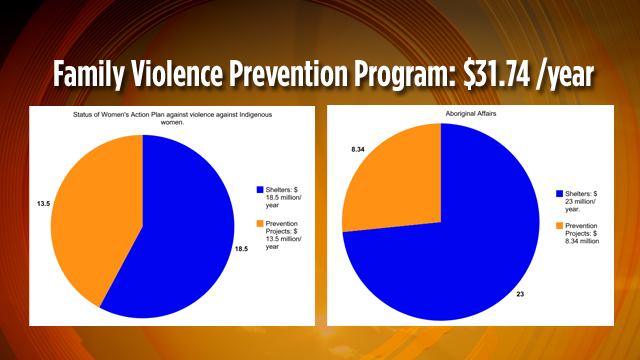Status of Women’s ‘Action Plan’ inflated Aboriginal Affairs’ violence prevention project spending by $24.5 million
The Harper government has reduced funding for shelters in 41 First Nation communities by millions of dollars, according to a comparison between Aboriginal Affairs numbers and those contained in an “Action Plan” to fight violence against Indigenous women.
By Jorge Barrera
APTN National News
When it released its “Action Plan” to fight violence against Indigenous women, the Harper government inflated by $24.5 million the amount of money Aboriginal Affairs planned to spend on reserve-based family violence prevention projects.
Status of Women’s “Action Plan,” released Sept. 15 claimed Aboriginal Affairs planned to spend $66.2 million over five years beginning in 2015 on “violence prevention activities” under its Family Violence Prevention Program (FVPP).
Aboriginal Affairs, however, said over the weekend it was spending $41.7 million over five years on violence prevention projects under FVPP.
The difference between the Action Plan figures and Aboriginal Affairs’ numbers is $24.5 million.
It’s unclear how Status of Women and Aboriginal Affairs arrived at different totals when both were talking about the same FVPP program money.
The FVPP program is getting $31.74 million a year beginning in 2015. It received a $1.34 million increase over the previous five years. This money is being transferred from a similar program previously housed under Canadian Heritage.
It appears Status of Women and Aboriginal Affairs divided the total differently.
The FVPP program is divided between funding for shelter services and violence prevention programs.
Status of Women’s Action Plan numbers also differ from Aboriginal Affairs’ figures on shelter funding.
The Action Plan states that, under the FVPP, shelters in 41 First Nation communities would get $18.5 million a year, beginning in 2015.
Aboriginal Affairs, however, said shelters would get $23 million a year under the program, with about $3.5 million of the total going to reimburse provinces and territories for shelter services.
Aboriginal Affairs released its figures over the weekend in a response to an APTN National News story published Friday that reported the Action Plan’s figures showed a cut to 41 First Nation shelters.
Aboriginal Affairs said there would be no cut and shelter funding would remain the same.
APTN National News contacted Status of Women Minister Kellie Leitch’s spokesperson to get clarity on the numbers on Friday. The minister’s office bounced the question to media relations office for Employment and Social Development Canada. The department then bounced the question to Aboriginal Affairs.
Aboriginal Affairs initially responded to APTN National News’ query Saturday, but, as of this article’s posting, had not answered additional questions on the discrepancy between how Status of Women divided FVPP’s funding versus how Aboriginal Affairs sliced the funding pie.
Liberal MP and Aboriginal affairs critic Carolyn Bennett said the Harper government is playing a “shell game” moving money between departments to create the perception it’s dealing with the issue while faced with persistent calls for a national inquiry.
“Regardless of the government’s desperate and confused backtracking on the apparent shelter cuts, it is clear that on-reserve shelters are already critically underfunded and maintaining the same 2010 funding is a completely inadequate response to this epidemic of violence,” said Bennett.
The NDP on Monday again pressed the government to call a national inquiry. Cree MP Romeo Saganash led the opposition charge.
Status of Women Minister Kellie Leitch reiterated the government was acting on the issue through its Action Plan.
Last Friday the NDP, who outnumbered the Conservatives in the House, triggered a debate on the need for a public inquiry into the high number of missing and murdered Indigenous women.
Saganash delivered an elegant and emotional speech about the need to hold an inquiry so the families of the missing can get some sense of closure. Saganash used his own mother as an example of how important closure is for those who do not know where their loved ones lie. Saganash said his brother Jonish died in residential school when he was only five years old in 1954. Saganash’s mother did not know where he was buried until 40 years later, when the little boy’s grave was discovered by his sister.
“It is only by coincidence, one day, that one of my sisters happened to be in the area and someone told her, ‘I know where your little brother is buried.’ After 40 years, my sister filmed the site where he was buried and brought the film back to my mom to show her,” said Saganash. “I do not know if any of the members have seen their mother cry, but I saw my mother cry many times, but the day she saw that video, I had never seen her cry that way. That was closure. That is what we call closure. That is the closest she could get to final closure for her son. That is what Indigenous families in this country need.
That is what they want. That is why they are calling for this national inquiry.”
The Conservative MPs across the floor where unmoved and the parliamentary secretary for status of women questioned whether Saganash supported the need to break intergenerational cycles of violence.
“Does he not think that addressing underlying causes of violence through structured training initiatives are important?” said Status of Women parliamentary secretary Susan Truppe.
Saganash said in response that no plan would work without first understanding the root causes
@JorgeBarrera










